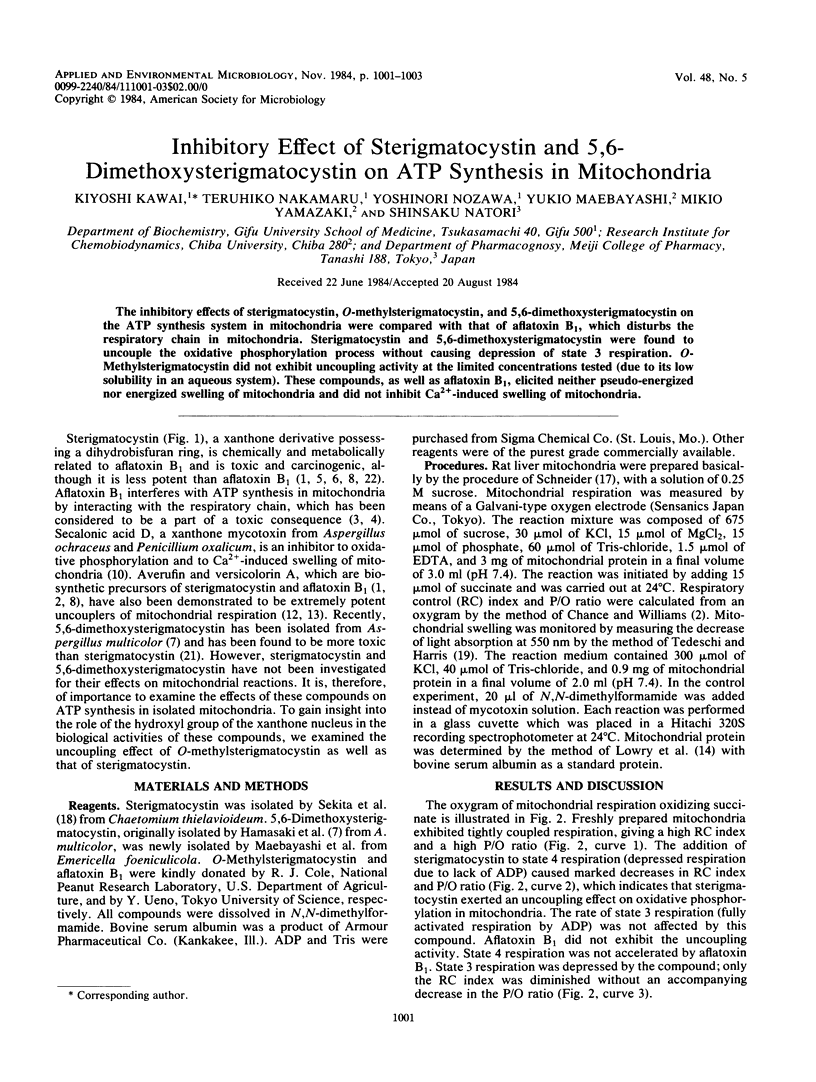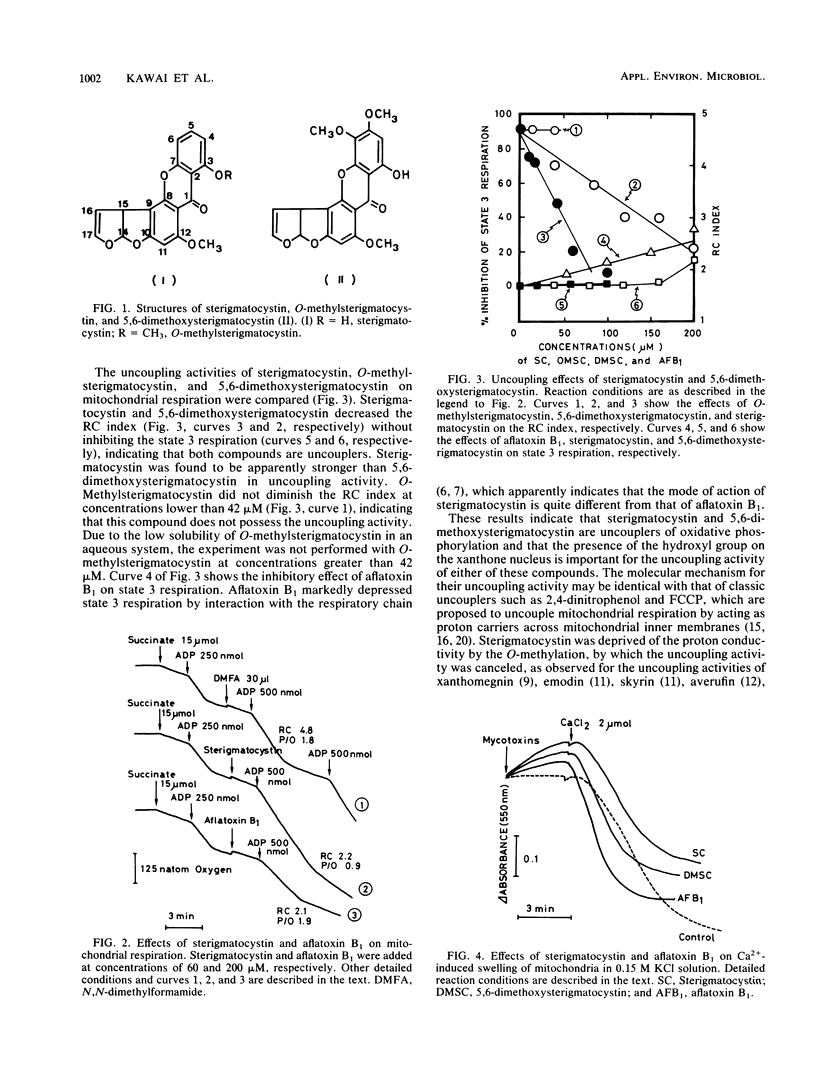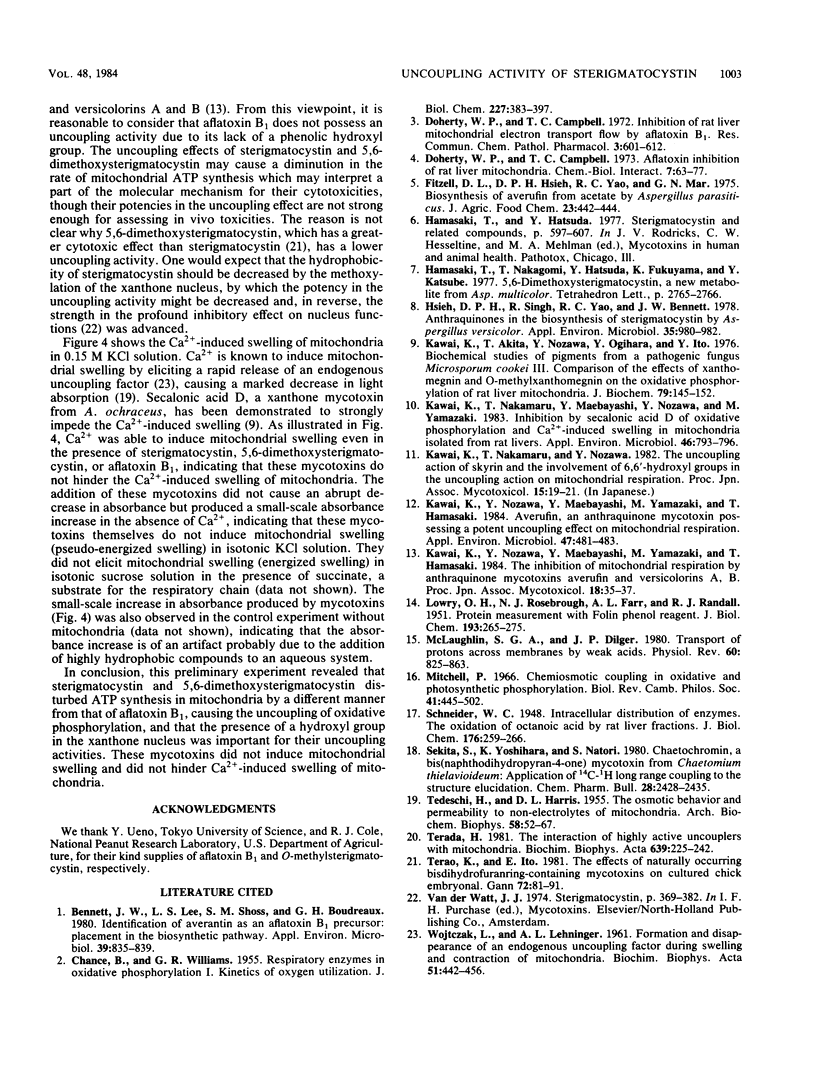Abstract
The inhibitory effects of sterigmatocystin, O-methylsterigmatocystin, and 5,6-dimethoxysterigmatocystin on the ATP synthesis system in mitochondria were compared with that of aflatoxin B1, which disturbs the respiratory chain in mitochondria. Sterigmatocystin and 5,6-dimethoxysterigmatocystin were found to uncouple the oxidative phosphorylation process without causing depression of state 3 respiration. O-Methylsterigmatocystin did not exhibit uncoupling activity at the limited concentrations tested (due to its low solubility in an aqueous system). These compounds, as well as aflatoxin B1, elicited neither pseudo-energized nor energized swelling of mitochondria and did not inhibit Ca2+-induced swelling of mitochondria.
Full text
PDF


Selected References
These references are in PubMed. This may not be the complete list of references from this article.
- Bennett J. W., Lee L. S., Shoss S. M., Boudreaux G. H. Identification of averantin as an aflatoxin B1 precursor: placement in the biosynthetic pathway. Appl Environ Microbiol. 1980 Apr;39(4):835–839. doi: 10.1128/aem.39.4.835-839.1980. [DOI] [PMC free article] [PubMed] [Google Scholar]
- CHANCE B., WILLIAMS G. R. Respiratory enzymes in oxidative phosphorylation. I. Kinetics of oxygen utilization. J Biol Chem. 1955 Nov;217(1):383–393. [PubMed] [Google Scholar]
- Doherty W. P., Campbell T. C. Aflatoxin inhibition of rat liver mitochondria. Chem Biol Interact. 1973 Aug;7(2):63–77. doi: 10.1016/0009-2797(73)90016-1. [DOI] [PubMed] [Google Scholar]
- Doherty W. P., Campbell T. C. Inhibition of rat liver mitochondria electron transport flow by aflatoxin B 1 . Res Commun Chem Pathol Pharmacol. 1972 May;3(3):601–612. [PubMed] [Google Scholar]
- Fitzell D. L., Hsieh D. P., Yao R. C., La Mar G. N. Biosynthesis of averufin from acetate by Aspergillus parasiticus. J Agric Food Chem. 1975 May-Jun;23(3):442–444. doi: 10.1021/jf60199a039. [DOI] [PubMed] [Google Scholar]
- Hsieh D. P., Singh R., Yao R. C., Bennett J. W. Anthraquinones in the biosynthesis of sterigmatocystin by Aspergillus versicolor. Appl Environ Microbiol. 1978 May;35(5):980–982. doi: 10.1128/aem.35.5.980-982.1978. [DOI] [PMC free article] [PubMed] [Google Scholar]
- Kawai K., Akita T., Nishibe S., Nozawa Y., Ogihara Y., Ito Y. Biochemical studies of pigments from a pathogenic fungus Microsporum cookei. III. Comparison of the effects of xanthomegnin and O-methylxanthomegnin on the oxidative phosphorylation of rat liver mitochondria. J Biochem. 1976 Jan;79(1):145–152. doi: 10.1093/oxfordjournals.jbchem.a131041. [DOI] [PubMed] [Google Scholar]
- Kawai K., Nakamaru T., Maebayashi Y., Nozawa Y., Yamazaki M. Inhibition by secalonic acid D of oxidative phosphorylation and Ca2+-induced swelling in mitochondria isolated from rat livers. Appl Environ Microbiol. 1983 Oct;46(4):793–796. doi: 10.1128/aem.46.4.793-796.1983. [DOI] [PMC free article] [PubMed] [Google Scholar]
- Kawai K., Nozawa Y., Maebayashi Y., Yamazaki M., Hamasaki T. Averufin, an anthraquinone mycotoxin possessing a potent uncoupling effect on mitochondrial respiration. Appl Environ Microbiol. 1984 Mar;47(3):481–483. doi: 10.1128/aem.47.3.481-483.1984. [DOI] [PMC free article] [PubMed] [Google Scholar]
- LOWRY O. H., ROSEBROUGH N. J., FARR A. L., RANDALL R. J. Protein measurement with the Folin phenol reagent. J Biol Chem. 1951 Nov;193(1):265–275. [PubMed] [Google Scholar]
- McLaughlin S. G., Dilger J. P. Transport of protons across membranes by weak acids. Physiol Rev. 1980 Jul;60(3):825–863. doi: 10.1152/physrev.1980.60.3.825. [DOI] [PubMed] [Google Scholar]
- Mitchell P. Chemiosmotic coupling in oxidative and photosynthetic phosphorylation. Biol Rev Camb Philos Soc. 1966 Aug;41(3):445–502. doi: 10.1111/j.1469-185x.1966.tb01501.x. [DOI] [PubMed] [Google Scholar]
- TEDESCHI H., HARRIS D. L. The osmotic behavior and permeability to non-electrolytes of mitochondria. Arch Biochem Biophys. 1955 Sep;58(1):52–67. doi: 10.1016/0003-9861(55)90092-8. [DOI] [PubMed] [Google Scholar]
- Terada H. The interaction of highly active uncouplers with mitochondria. Biochim Biophys Acta. 1981 Dec 30;639(3-4):225–242. doi: 10.1016/0304-4173(81)90011-2. [DOI] [PubMed] [Google Scholar]
- Terao K., Ito E. The effects of naturally occurring bisdihydrofuran ring-containing mycotoxins on cultured chick embryonal hepatocytes. Gan. 1981 Feb;72(1):81–91. [PubMed] [Google Scholar]
- WOJTCZAK L., LEHNINGER A. L. Formation and disappearance of an endogenous uncoupling factor during swelling and contraction of mitochondria. Biochim Biophys Acta. 1961 Aug 19;51:442–456. doi: 10.1016/0006-3002(61)90600-x. [DOI] [PubMed] [Google Scholar]


